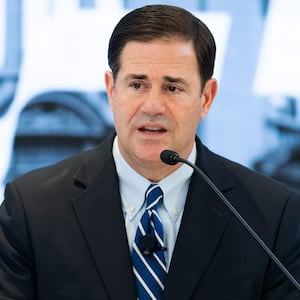When Arizona received its first shipments of the COVID-19 vaccine in early December, emergency room nurse Nicole Koller saw a first ray of hope in the seemingly unending horror that had arrived with a post-Thanksgiving surge.
The 47-year-old traveling nurse filled out an online “pre-screening survey” and figured she and the other health care workers battling COVID day after day at Banner University Medical Center in Phoenix would be among the first to get vaccinated.
But in a sign of the national dysfunction over vaccine distribution, Koller was told she could expect to wait up to six weeks because of a “computer glitch.” She kept pushing, though, and after an inquiry by The Daily Beast, the Maricopa County Health Department arranged for her to get a shot on Dec. 28—nearly two weeks after she first applied.
Now, she has COVID.
“If I had gotten my vaccine a week before, my outcome could have been different,” she told The Daily Beast this week. “Maybe not, but I wonder about it.”
Had she received a shot when she first applied on Dec. 16 , Koller might have stood at least a chance for some immunity at year’s end.
She might not have been so fatigued on New Year’s Eve that she spent it in bed. She told herself she was just exhausted by 12-and-a-half hour shifts during a surge in which too many people continued to insist COVID is just a flu and still refused to wear masks.
“Between how sick people are and constantly arguing with people who are still saying stupid things, it is just exhausting,” she told The Daily Beast. “I thought it was just getting to me, this constantly seeing people die and short of breath.”
But as exhausted as she woke on Jan. 1, Koller still reported for duty at a COVID unit at Banner University Medical Center in Phoenix, Arizona at 7 a.m. Her patients included a man who was not wearing his mask when she entered with antibiotics as well as steroids and a nebulizer to assist his breathing.
“He had some very choice words about putting on a mask, ” she recalled. “He said it’s his room and he shouldn’t have to wear a mask in his room. I said, ‘Hey, you’re protecting yourself as well as me.’”
The man continued to insist that he should not have to wear a mask in his room.
“You try not to let it get to you because you know people are not feeling well,” Koller later said. “But it does get to you.”
Such encounters might have accounted for her fatigue, but they didn't explain breaking out in a cold sweat during the shift.
“I was drenched,” she recalled.
And the nurse could not ascribe it to being of menopausal age.
“I thought, ‘This is the strangest hot flashes I ever had. I’m cold, not hot,’” she recalled. “I thought, ‘This isn’t good.’ I thought something's wrong, but I wasn’t totally sure.”
She had the first concern of all decent who suspect they may have the virus.
“You worry about causing harm,” she remembered. “But at least I have an N95 (mask) and face shield. I’m thinking, ‘I’m taking care of COVID patients, so I don’t think I could make anything worse.’”
The cold sweats continued after she went off duty at 7:30 p.m.
“I went home and had to change clothes three times because they were drenched through,” she remembered.
She is a traveling nurse on contract, so she had to pay out of pocket for a COVID-19 test the next day. She stayed home pending the result, which came back the following afternoon: “Detected.”
“It appears I have COVID,” she told The Daily Beast on Sunday.
She had been religious about taking all the recommended precautions on- and off-duty. But she had been required to reuse an N95 at work and figured she had become infected while working constantly around COVID. She described her symptoms as “pretty bad—sore from head to toe, cold, sweaty, cough, etc., but stable.”
She felt worse the following afternoon.
“Bit of a rough day,” she said. “I’m afraid I’m not feeling very well.”
She has asthma and became alarmed when she began to have trouble breathing. But she seemed to be improving two days later.
“It was a little scary, as my lungs started to be affected,” she said. “I can breathe easier today.”
She further reported, “My chest doesn’t hurt as much. It’s still hard to take deep breaths... I’m a little short of breath.”
But she couldn't help but think that she might have been spared any symptoms had her shot not been delayed by that that “computer glitch.”
The vaccine had been approved for emergency use at what the Trump administration described as “warp speed,” but it was being administered at the usual pace of government in Maricopa and seemingly everywhere else in the country. Koller could not understand why officials were not acting as if lives were at stake.
“It’s incredibly sad to me,” she said. “It seems like it would be the highest priority.”
The emergency use had lost a sense of emergency. Millions of doses were sitting unadministered while officials fretted over schedules and plans. She decided that they were so worried about people receiving the vaccine in the wrong order that too few people were getting it at all.
“Plans, not people,” Koller said.
Vials were sitting on a freezer shelf in Maricopa County on a day that Koller’s hospital ran out of body bags.
“They know people are going to keep getting sick and keep dying,” she said of health officials across America. “They should be constantly giving vaccine out, 24 hours a day, seven days a week, until it’s gone. I just don’t understand why that isn’t happening already.”
And, even if everybody were vaccinated tomorrow, there would still have to be a second dose, followed by another period before immunity kicks in.
“They know it takes time, right?” she asked.
Too many officials are acting as if they have all the time in the world, working business hours, with weekends and holidays off.
And meanwhile, the virus keeps spiking, making so many people sick that there are shortages in everything from ICU beds to oxygen to PPE.
“We are mandated to use our N95 masks for two weeks in a row,” Koller said of her hospital. “We ran out of the protective gowns a week ago.”
The daily COVID death toll in America has topped 4,000 and may jump even higher in the days ahead as a post-Christmas surge kicks in. As a nurse who has fallen ill on the front line in the fight against COVID, Koller knows that those who ignore the precautions are missing the essential element of patriotism.
“It seems like the most patriotic thing you can do is to protect the people around you, your family, your friends, the community, and that seems to be missing,” Koller said.
She spoke as a true patriot.
“I want people to be safe,” she said. “Everyone I care about and everyone I don’t care about.”
She knows that people are impatient to get back to their normal lives.
“They want to be happy and see all their friends and pretend it’s great,” she said. “I don’t know how you can pretend everything is great when so many people are dying.”
As a nurse, she would love to get back to when she can again give a patient a kiss on the forehead or hold their hand. She retains a core desire to comfort and heal that she brought to emergency nursing 26 years ago.
“It’s been heartbreaking working through this,” she said of the COVID fight.
And it will get only more wrenching until health officials everywhere put the vaccines to emergency use like we are in the biggest emergency in our history.
At least Koller seems to be prevailing in her personal battle with COVID.
“I am continuing to get better each day now,” she said. “So that’s good.”



